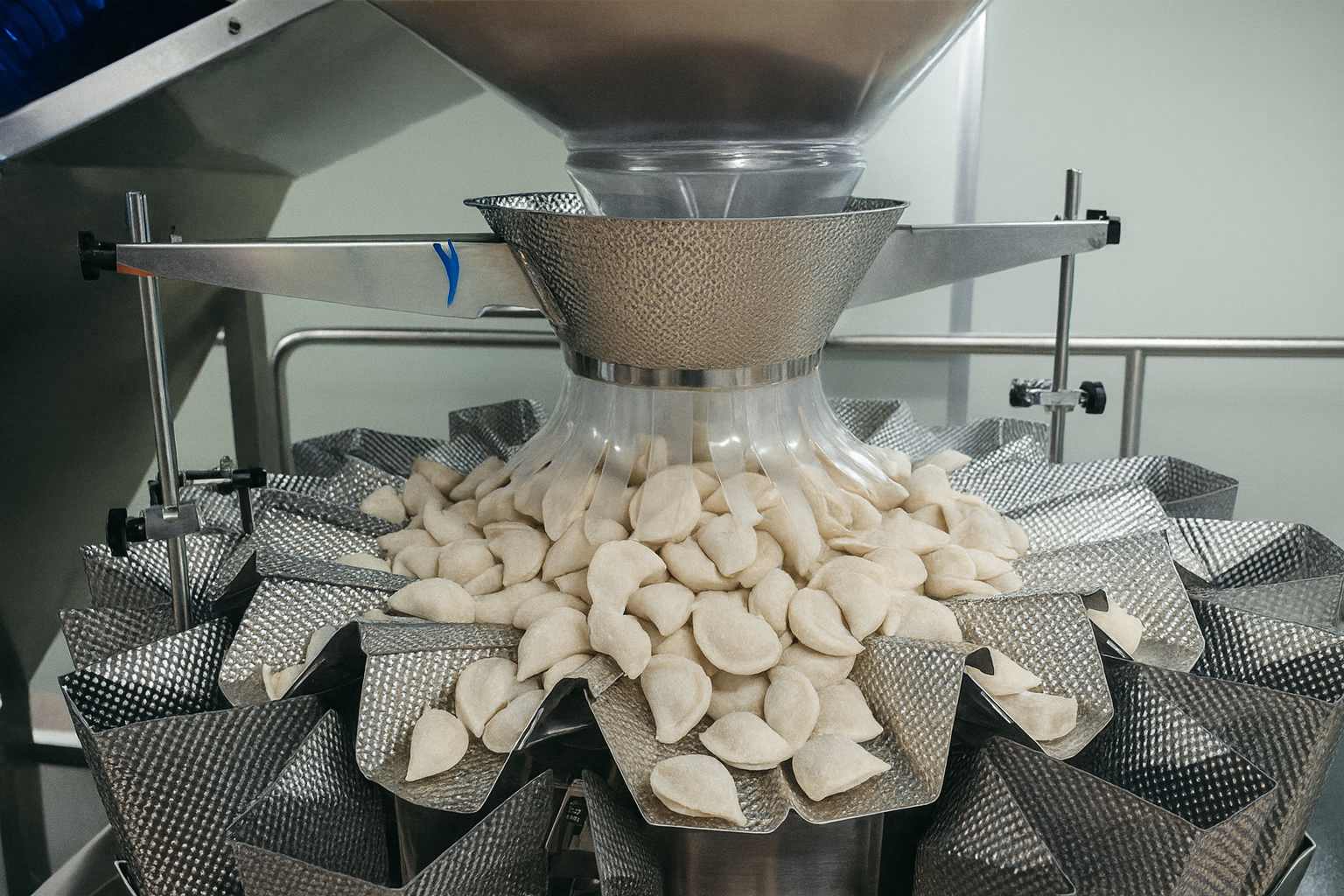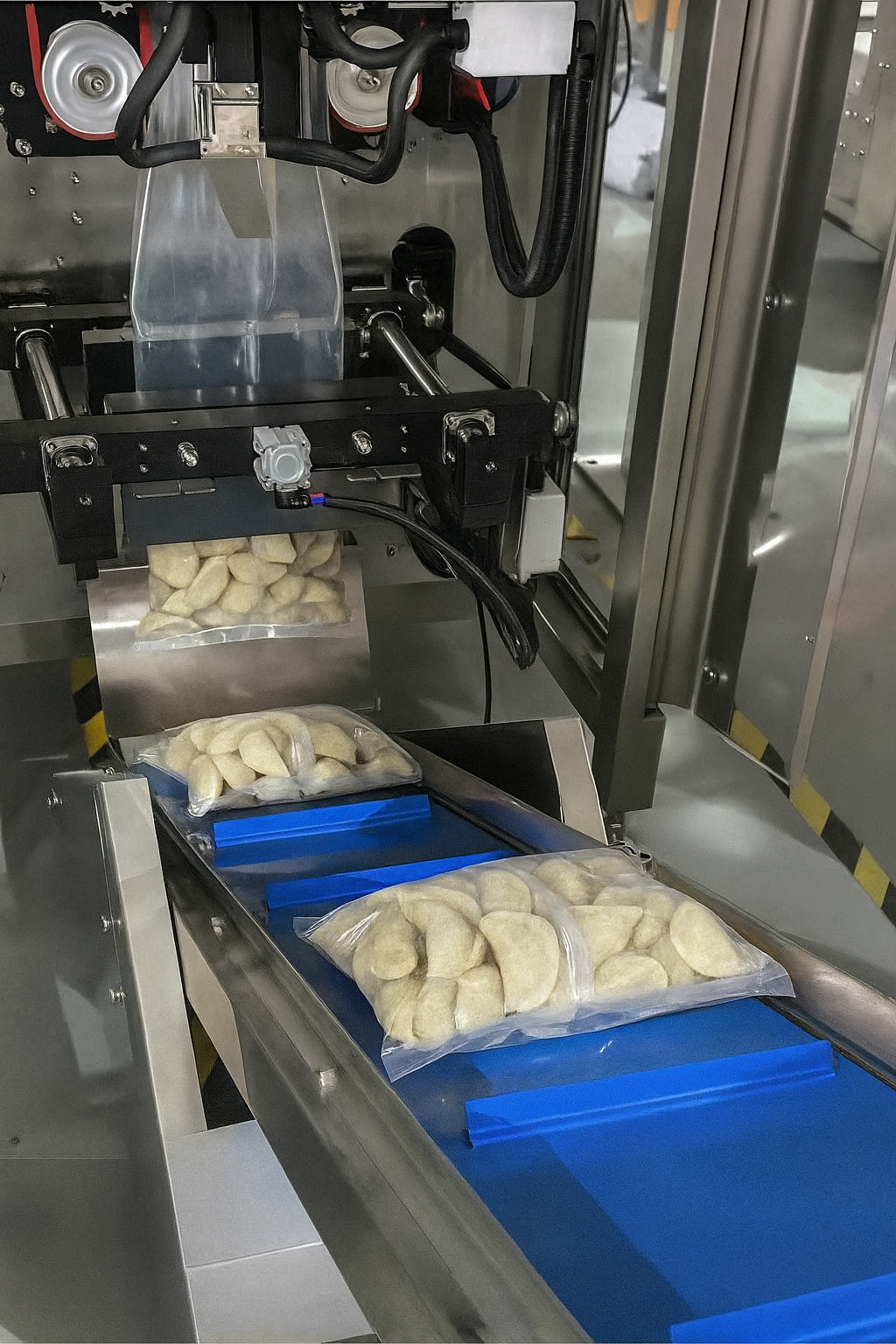Introduction: Packaging & Machinery in the Frozen Foods Revolution
In 2025, frozen food packaging is inseparable from the machines that make it possible. Packaging machines — from form‑fill‑seal equipment to tray sealers, vacuum machines, MAP (Modified Atmosphere Packaging) lines, and automatic frozen food packaging machines — are central to delivering quality, consistency, and efficiency. As demand for frozen meals, vegetables, protein‑rich and plant‑based products rises, so does the pressure on packaging machines to perform at higher speeds, with greater reliability, and under stricter hygiene and sustainability standards.
Consumer expectations are pushing machine OEMs to adapt. People expect not only safe, tasty frozen food, but also packaging that communicates health, origin, and environmental credentials. Machines must support these features: printing high‑clarity labels, enabling smart labels, integrating sensors, and accommodating a variety of packaging formats while maintaining throughput.
If you are a food brand or manufacturer considering upgrading your packaging line, selecting the right frozen food packaging machine is no small decision. You need machinery that can handle low‑temperature sealing, high-barrier films, flexible formats, and possibly sustainability‐oriented materials like compostables or monomaterials. The design of the machine must match the packaging innovation trends, or else your packaging becomes the weak link, not the selling point.

Market Overview: Size, Forecast & Regional Machinery Demand
Recent market reports show that the frozen food packaging machines market is poised for solid growth:
- The frozen food packaging machines market was valued around USD 1.64 billion in 2023 and is projected to reach about USD 2.62 billion by 2033, growing at a CAGR of ~4.8%. Future Market Insights
- Another source reports that automated systems make up more than 55% of new installations, as efficiency, lower labor costs, and speed are prioritized. Global Growth Insights
- Manufacturers are also emphasizing energy‑efficient machines to reduce operating costs—over 40% of them list that as a priority. Global Growth Insights
Regional Hubs of Machine Adoption
-
Asia‑Pacific (especially China, South Asia) is leading in demand for frozen food packaging machines. Rapid urbanization, rising incomes, growth in retail & online grocery are driving adoption. Future Market Insights+1
-
Europe remains strong in demand for high‑performance, sustainable machines due to stricter regulations, high consumer expectations, and the presence of OEMs leading in innovation.
-
North America is also investing heavily, particularly where automation, sustainability, and traceability are required, and in markets with ready meals or frozen protein products.
For potential clients, it’s useful to note: choosing a machine compatible with your region’s regulatory and infrastructure pressures (e.g. power supply, cold chain, safety & hygiene standards) can save costs long term.
Key Trends Impacting Machine Buyers in 2025
Convenience, Health, and Machine Compatibility
As consumers demand clean labels (organic, plant‑based, low additives), convenience (ready meals, heat‑and‑serve trays, resealable packaging), your frozen food packaging machine must be able to handle:
- High barrier films that preserve nutrients
- Fast changeover between formats and tray sizes
- Sterile or food safety features (easy cleaning, minimal contamination)
When buying a machine, check whether it supports flexible packaging formats, modular design (so you can upgrade), and whether it prints labeling clearly (nutrition, QR codes, certifications).
Global Flavors & Design Demands on Machines
Beyond function, packaging is a visual story. For frozen foods with global flavors (Asian dumplings, Mexican burritos, Mediterranean combos, etc.), packaging designs may require multilingual labels, cultural artwork, and vivid printing. Thus, the packaging machine (or ancillary equipment) must support:
- High‑resolution printing
- Color management
- Variable data printing (for lot codes, batch info, etc.)
A machine that lags here can limit how attractive your packaged product will look in markets where design and packaging storytelling matter.
Mini / Single‑Serve & Machinery Flexibility
Demand for snack‑sized, single‑serve frozen foods is rising. For manufacturers, this means packaging machines must be flexible in output size:
- Ability to seal smaller packs at high speed
- Modular systems that allow switching between single‑serve and larger packs without full line shutdowns
- Portion control features, reliable sealing on small films/trays
If you’re supplying a packaging line, you’ll want machines that offer this flexibility, to respond to market changes quickly.
Machinery Innovation & Automation in Packaging Lines
Smart Packaging Machines: Sensors, IoT, Traceability
2025 global frozen food packaging market trends show that smart machines are becoming standard. Machines with integrated sensors for temperature, seal integrity, leak detection, or automated quality checks (vision systems) are in demand. IoT connectivity allows monitoring of machine performance, predictive maintenance, avoiding downtime.
Traceability is also critical: being able to scan or track every package throughout the cold chain via RFID/NFC or QR code ensures food safety and builds consumer trust. Machines that support these features help you meet regulatory and consumer expectations.
Integration of MAP, Vacuum Sealing, etc.
Advanced packaging lines include machines capable of modified atmosphere packaging (MAP), vacuum sealing, or even active packaging (oxygen scavengers, etc.). These machines extend shelf life, preserve flavor & texture, and reduce waste. For frozen foods, where freezer burn or moisture ingress degrade product, these technologies are essential.
If you’re investing in a frozen food packaging machine, consider whether it supports MAP or vacuum modules, and whether the machine line can seal and handle barrier trays or films well under freezing conditions.
Energy‑Efficient, High‑Speed, Automated Machines
Because operating costs (energy, labor, maintenance) are large in frozen food packaging, many manufacturers want machines that are:
- High throughput (speed)
- Low energy consumption
- Automated in material feeding, sealing, and labeling
Automation also reduces labor costs and error rates. Reports show that many new machine installations are in automated systems. Global Growth Insights+1
Sustainability in Packaging Machines & Materials
Materials & Machine Adaptation
Sustainable packaging materials—such as biodegradable plastics, compostables, paperboard with coatings, monomaterials—offer environmental benefits, but they often behave differently in machines (seal differently, need different temperatures, different speeds). A packaging machine must have adjustable parameters to handle these materials without compromising seal integrity or throughput.
Reducing Material Waste & Optimizing Machine Efficiency
Better machine design (precision sealing, film alignment, good maintenance) reduces rejected/failed packs which lowers wasted materials. Machines that are modular or have quick changeover reduce downtime and thus reduce waste. Energy recovery, efficient motors, and insulation can also cut energy use.
Regulatory Compliance & Eco‑Friendly Machine Features
Machines must often meet local regulations regarding hygiene, energy consumption, waste, emissions. Buyers should ensure their packaging machine solutions comply with relevant standards (e.g., food safety certifications, energy efficiency, waste management). Some markets may require certain eco labels on packaging, or may ban certain plastics. Machines that can handle recyclable or compostable materials give you future‑proofing.
Competitive Landscape: Machine Manufacturers & Partnerships
-
Key machine manufacturers are investing in R&D to build packaging lines that incorporate MAP, vacuum sealing, smart sensors, flexible formats, and sustainability.
-
Brand owners increasingly partner with packaging machine makers or material innovators to co‑develop custom frozen food packaging machine solutions that fit their specific product type.
-
After‑sales service, spare parts, technical support, and machine training become strong differentiators; clients often pick packaging machine suppliers who provide strong lifecycle support.
If you are evaluating machinery suppliers, look for those that can offer modular upgrades, customization (for your exact frozen food product), and good ongoing service.
Challenges & Opportunities for Machinery Buyers
-
Initial capital investment is high for automated, energy‑efficient packaging lines with advanced features.
-
Cold chain infrastructure must match your packaging machine’s capabilities; poor cold storage or transport can reduce benefits of advanced packaging.
-
Material availability (especially for sustainable films, biodegradable materials) can be inconsistent, and machines need to be compatible.
-
Balancing speed vs quality vs flexibility: a machine optimized for very high throughput may sacrifice flexibility, or vice versa.
Opportunities include being early to adopt sustainable/efficient machines (which may give cost advantages or consumer goodwill), and tapping into growth in e‑commerce / ready meals with packaging solutions tailored to your channel.
Future Outlook: Capturing Growth Through Smart Machine Investments
To capitalize on 2025 global frozen food packaging market trends, machine buyers should:
-
Set clear sustainability goals (e.g. carbon footprint, waste reduction) and choose machines that support those goals.
-
Opt for modular, upgradeable machines so you can adapt as you grow or as material/packaging formats evolve.
-
Use data from machine sensors, IoT, and quality monitoring to optimize production, reduce downtime, lower costs.
-
Invest in staff training & maintenance so your machine operates reliably and efficiently.

Conclusion
The 2025 global frozen food packaging market trends are being shaped not just by materials, consumer preferences, and sustainability—but heavily by the capabilities of the packaging machines that make it all possible. For frozen food producers, restaurateurs, or brands planning to scale, investing in the right frozen food packaging machine is as important as product innovation. Machines that are smart, flexible, sustainable, high‑speed, and well supported will differentiate your business in a competitive marketplace.
Frequently Asked Questions (FAQs)
-
What features should I look for in a frozen food packaging machine?
Look for compatibility with high-barrier films, MAP or vacuum sealing modules, adjustable temperature and speed settings, smart sensor integration (seal integrity and temperature), support for sustainable materials, and good after-sales support. -
Is automation in packaging machines worth the investment?
Yes—automated frozen food packaging machines often reduce labor costs, improve consistency, reduce waste, and increase throughput. Over time, savings in energy, material waste, and labor often offset higher capital cost. -
How can a machine help with sustainability in frozen food packaging?
Machines that support recyclable or compostable materials, enable precise sealing to prevent leaks/wastage, optimized energy‐use motors, modular design to reduce changeover waste—all these contribute. Also, machines that support single‑material packaging designs are easier to recycle. -
What types of frozen foods are best suited for modern packaging machines?
Ready meals, frozen vegetables, proteins (meat, fish), snack‑size items, and single‑serve desserts all benefit. The better your machine matches the product’s needs (texture, freezing method, package size), the better the outcome. -
How do I choose between suppliers of packaging machines?
Compare based on machine reliability, speed, adaptability (formats & materials), sustainability compatibility, support & maintenance, total cost of ownership (not just purchase price), and whether they offer customization for your product needs.

